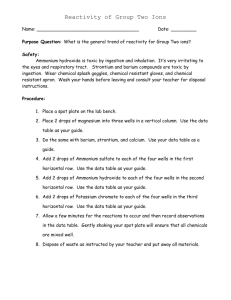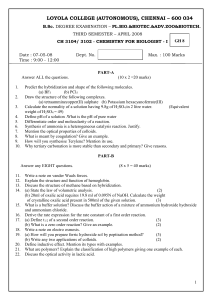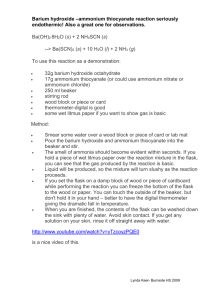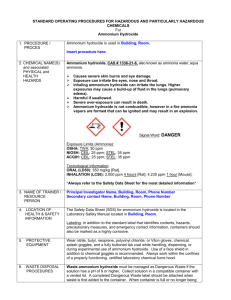Ammonium Hydroxide
advertisement
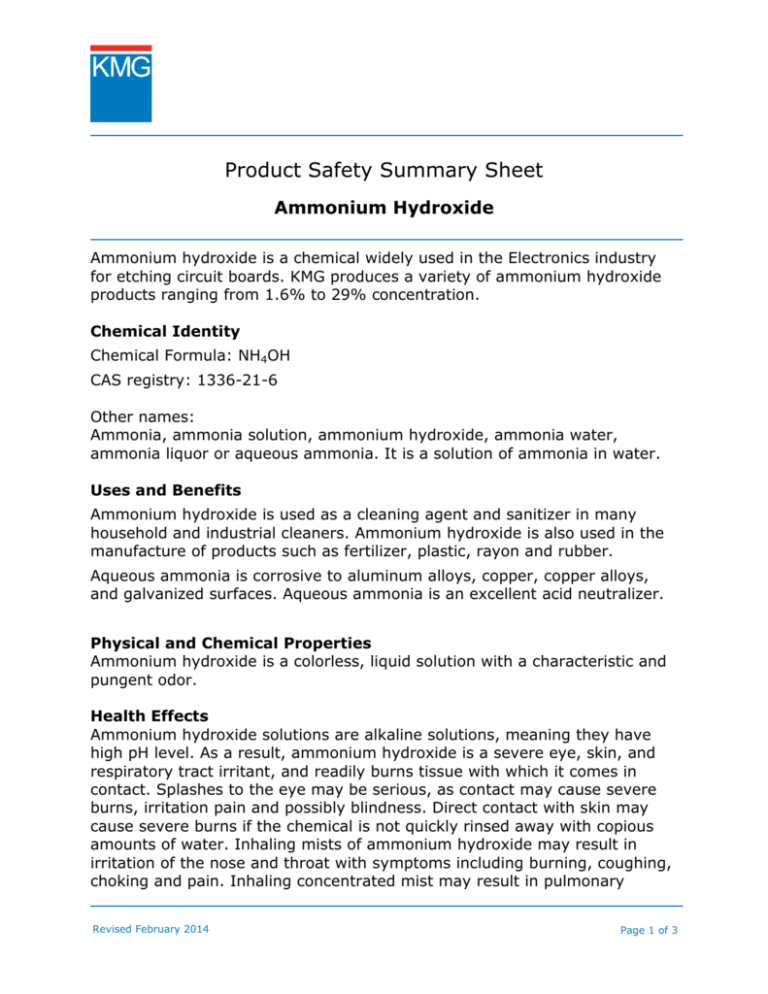
Product Safety Summary Sheet Ammonium Hydroxide Ammonium hydroxide is a chemical widely used in the Electronics industry for etching circuit boards. KMG produces a variety of ammonium hydroxide products ranging from 1.6% to 29% concentration. Chemical Identity Chemical Formula: NH4OH CAS registry: 1336-21-6 Other names: Ammonia, ammonia solution, ammonium hydroxide, ammonia water, ammonia liquor or aqueous ammonia. It is a solution of ammonia in water. Uses and Benefits Ammonium hydroxide is used as a cleaning agent and sanitizer in many household and industrial cleaners. Ammonium hydroxide is also used in the manufacture of products such as fertilizer, plastic, rayon and rubber. Aqueous ammonia is corrosive to aluminum alloys, copper, copper alloys, and galvanized surfaces. Aqueous ammonia is an excellent acid neutralizer. Physical and Chemical Properties Ammonium hydroxide is a colorless, liquid solution with a characteristic and pungent odor. Health Effects Ammonium hydroxide solutions are alkaline solutions, meaning they have high pH level. As a result, ammonium hydroxide is a severe eye, skin, and respiratory tract irritant, and readily burns tissue with which it comes in contact. Splashes to the eye may be serious, as contact may cause severe burns, irritation pain and possibly blindness. Direct contact with skin may cause severe burns if the chemical is not quickly rinsed away with copious amounts of water. Inhaling mists of ammonium hydroxide may result in irritation of the nose and throat with symptoms including burning, coughing, choking and pain. Inhaling concentrated mist may result in pulmonary Revised February 2014 Page 1 of 3 edema and shock. Ingesting ammonium hydroxide may cause pain and burns of the esophagus and gastrointestinal tract. Environmental Risks Ammonium hydroxide is moderately toxic to aquatic organisms. It can elevate the pH of ecosystems that are not well buffered. Exposure Potential and Risk Management Measures Ammonia vapor at levels higher than those found in common household cleaners is an irritant to the eyes, mucous membranes and lungs. Consuming ammonia orally can cause burns to the mouth, throat and stomach. Because ammonia has a strong, unpleasant odor and taste, nonaccidental ingestion is highly unlikely. KMG employees who handle ammonium hydroxide are trained how to handle the chemical safely. They are supplied with the suitable personal protective equipment for the job and are instructed in the correct usage and care of the equipment. Industrial Use Ammonium hydroxide is utilized in numerous applications: In furniture making, ammonium hydroxide is used to darken or stain wood containing tannic acid. In food production, ammonium hydroxide is used as a leavening agent or acidity regulator and is classified by the Food and Drug Administration as generally recognized as safe (GRAS). Its pH control abilities make it an effective antimicrobial agent. Ammonium hydroxide is also used to treat straw, producing "ammoniated straw" that is edible for cattle. In the tobacco industry, ammonium hydroxide is used for flavor enhancement and as a processing aid. Aqueous ammonia is used in the laboratory most often as a complexant and base in inorganic analysis. It can dissolve silver residues, and when used with copper (II) solutions, provides a deep blue coloration. Consumer Use Diluted ammonium hydroxide, also known as household ammonia, is a common ingredient in numerous cleaning agents, including many window cleaning formulas. In addition to use as an ingredient in cleansers, diluted Revised February 2014 Page 2 of 3 ammonium hydroxide is also sold as a cleaning agent by itself, usually labeled simply as "ammonia." It is often sold plain, lemon-scented or pinescented. Regulatory Information Since ammonium hydroxide is used in many products, it is regulated by various governmental agencies depending on the amount and type of usage. Conclusion Ammonium hydroxide has been used safely and extensively over a long period of time. As a result, there is abundant data and information available to enable the safe handling and usage of this chemical. Contact Information KMG Chemicals, Inc., Houston, Texas 77099 Electronic Chemicals Phone: 1-713-600-3800 Hours: 7:00 a.m.-4:00 p.m. Central This document is provided for informational purposes only and is based on technical information that to the best knowledge of KMG Chemicals, Inc. on the date issued, is believed to be reliable. This document refers only to the specific material named and does not relate to its use in combination with any other material or process. This document is provided at no charge and accordingly, no warranties of any kind, express or implied, are made regarding the technical data and information provided. Furthermore, KMG assumes no liability or obligation in connection with use of this information. To obtain the most accurate and current information, consult the appropriate Safety Data Sheet (SDS), available on the KMG Chemicals website, prior to use of the material named herein. KMG reserves the right to amend and update this information at any time. Revised February 2014 Page 3 of 3
